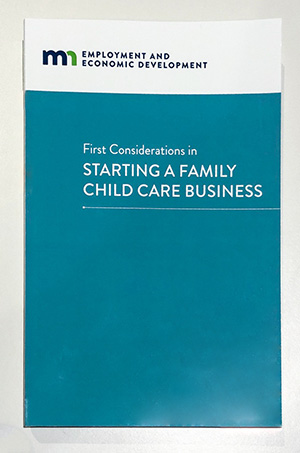2/26/2019 1:11:35 PM
For many Minnesota families, child care is a necessity, yet a growing number of Minnesotans can’t access it – it just doesn’t exist. The number of licensed family childcare providers has decreased almost 30 percent in Minnesota since 2005, according to the Minnesota Department of Human Services. Census data from 2014 show that about 310,000 children in Minnesota ages 0-5 have both parents or guardians in the workforce and likely need some form of child care.
Lack of affordable, quality child care is a significant barrier to workforce participation that can negatively affect job and wealth creation, business expansion and retention, and new business location. The safety, well-being, and early education of children, as well as support for their families, are critical to the health of our state. To help combat this problem, Governor Tim Walz recommends $1 million over the biennium for the Child Care Economic Development Grant program.
This funding will provide grants to communities to increase the supply of child care to reduce regional child care shortages, and to support increased workforce participation, business expansion and retention, and new business development. Priority will be given to communities that have a proven shortage of child care providers, are experiencing above average workforce shortages, and experiencing lower than average prime-age workforce participation rates.
 Over the course of the two previous rounds of funding in State Fiscal Year 2017 and 2018, DEED received 39 proposals totaling $3 million in request for $1 million in available funds. A total of 15 awards were made leveraging a total local match of $2.6 million.
Over the course of the two previous rounds of funding in State Fiscal Year 2017 and 2018, DEED received 39 proposals totaling $3 million in request for $1 million in available funds. A total of 15 awards were made leveraging a total local match of $2.6 million.
These projects are projected to provide child care services to an additional 2,131 children when facilities reach their full licensed capacity.
Communities throughout Minnesota have expressed strong demand for these funds and have demonstrated that there are a large number of projects ready to go to expand child care capacity should additional funding be made available.
Based on the past two appropriations it is estimated that an additional $1 million would leverage over $2 million in local matching funds, result in 14-20 new projects and have the ability to serve an additional 1,600-2,400 children and their families throughout Minnesota.
About 5,576,600 people made Minnesota their home in 2017, the U.S. Census Bureau notes. Of these, more than one million were children between the ages of 0 and 14 years – about one in every five Minnesotans. Outside of parents, grandparents, uncles, aunts, other legal guardians, and teachers, there is one major profession dedicated to minding these children: child care workers.
Child care workers attend to children at schools, businesses, private households, and child care institutions, according to the Standard Occupational Classification definition. Such workers perform a variety of tasks, such as dressing, feeding, bathing, and overseeing play. Common job titles are assistant teacher, caregiver, daycare teacher, infant teacher, and toddler teacher. No matter what the job title is, each child care worker essentially has the same tasks at work:
Other tasks may include supervising and assisting with homework, regulating children’s rest periods, taking attendance, making phone calls, and keeping records on individual children. Skills often sought in childcare workers commonly include monitoring and assessing skills, service orientation, social perceptiveness, active listening, and coordination. It also takes patience.
Currently, there are an estimated 11,550 child care workers in Minnesota, making it the state’s 55th largest-employing occupation (out of nearly 800). The median hourly wage for a child care worker in the state is $11.44, according to DEED’s Occupational Employment Statistics (OES).
For someone working full-time and year-round, this equates to an annual median wage of $23,795, below the median annual wage for the total of all jobs in the state, $41,746. It’s also below what an individual in Minnesota would need to earn to meet a basic needs budget, which was $31,656 in 2018.
According to DEED’s Job Vacancy Survey, employers across Minnesota reported nearly 1,200 child care worker vacancies during the second quarter of 2018 – up a remarkable 72 percent from 2017 and near record highs for such vacancies. In fact, there are more than 10 open child care worker positions for every 100 filled positions. Clearly, child care workers are in high demand across Minnesota. With such a high need, median wage offers are starting to climb, with $12.45 being the median hourly wage offer during the second quarter of 2018.
The demand for child care workers is anticipated to remain strong. Employment is projected to grow by 8.5 percent through 2026 (nearly 2,400 net new jobs), according to DEED’s Employment Outlook data. And more than 23,600 positions are projected to open up due to retirements or those leaving the occupation.
Those with a high school diploma should have little difficulty finding work as a childcare worker, especially for those who earn the Child Development Associate credential, through the Council for Professional Recognition. Certifications can also be sought through the National Early Childhood Program Accreditation.
 DEED has a free manual on how to start a family child care business.
DEED has a free manual on how to start a family child care business.
“First Considerations in Starting a Family Child Care Business” provides details on licensing, financing, state laws, child care resources and more.
“First Considerations in Starting a Family Child Care Business” covers six broad areas that often are barriers to successful entry into the field:
The manual is available in hard copy, CD or online. Customers can get a free hard copy or CD by calling 651-259-7476. A PDF of “First Considerations in Starting a Family Child Care Business” is available on the DEED website.
That’s what it does. But it’s just as important to know what it doesn’t cover: It’s not a book on child care policy. It doesn’t offer legal or tax advice. It’s not about curriculum design or the variety and number of child development activities centers can or should offer.
And it doesn’t provide counsel on every topic you’d need to know about if you’re starting a business in Minnesota. We have another guide for that.
business expansion
Economic Development
workforce